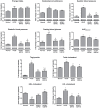The Effects of Vitamin E from Elaeis guineensis (Oil Palm) in a Rat Model of Bone Loss Due to Metabolic Syndrome
- PMID: 30149518
- PMCID: PMC6164987
- DOI: 10.3390/ijerph15091828
The Effects of Vitamin E from Elaeis guineensis (Oil Palm) in a Rat Model of Bone Loss Due to Metabolic Syndrome
Abstract
The beneficial effects of vitamin E in improving components of MetS or bone loss have been established. This study aimed to investigate the potential of palm vitamin E (PVE) as a single agent, targeting MetS and bone loss concurrently, using a MetS animal model. Twelve-week-old male Wistar rats were divided into five groups. The baseline group was sacrificed upon arrival. The normal group was given standard rat chow. The remaining three groups were fed with high-carbohydrate high-fat (HCHF) diet and treated with tocopherol-stripped corn oil (vehicle), 60 mg/kg or 100 mg/kg PVE. At the end of the study, the rats were evaluated for MetS parameters and bone density. After euthanasia, blood and femurs were harvested for the evaluation of lipid profile, bone histomorphometric analysis, and remodeling markers. PVE improved blood pressure, glycemic status, and lipid profile; increased osteoblast surface, osteoid surface, bone volume, and trabecular thickness, as well as decreased eroded surface and single-labeled surface. Administration of PVE also significantly reduced leptin level in the HCHF rats. PVE is a potential agent in concurrently preventing MetS and protecting bone loss. This may be, in part, achieved by reducing the leptin level and modulating the bone remodeling activity in male rats.
Keywords: dyslipidemia; hyperglycemia; hypertension; obesity; osteoporosis; tocopherol; tocotrienol.
Conflict of interest statement
The authors declare no conflict of interest.
Figures

References
-
- Alberti K.G., Eckel R.H., Grundy S.M., Zimmet P.Z., Cleeman J.I., Donato K.A., Fruchart J.C., James W.P., Loria C.M., Smith S.C., Jr. Harmonizing the metabolic syndrome: A joint interim statement of the International Diabetes Federation Task Force on Epidemiology and Prevention; National Heart, Lung, and Blood Institute; American Heart Association; World Heart Federation; International Atherosclerosis Society; and International Association for the Study of Obesity. Circulation. 2009;120:1640–1645. - PubMed
Publication types
MeSH terms
Substances
LinkOut - more resources
Full Text Sources
Other Literature Sources
Medical

